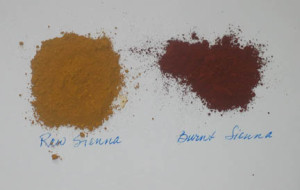And more uses for those siennas. Raw sienna used here, mixed with white, lead-tin yellow, and black makes great variations of tones for this application. Painting #9 detail. … [Read more...] about And More!
Pigments: Historical and Modern
There is a distinct difference between modern day pigments and the natural pigments used prior to the middle of the 1700s. In the past, artists had apprentices who ground the colors for them throughout the oil painting sessions. Because they were made by hand, the pigments retained a natural grittiness and consistency with larger particle size. Today's oil paint manufacturers make synthetic colors in huge vats where the end result is exceptional smoothness. Prior to the middle of the 1700, natural pigments came from dirt, minerals, and even plants.
Geology Burnt Sienna, 101
Burnt sienna, also known as Caledonian brown and terra di Siena, comes in a variety of shades, depending on its source. It gets its rich dark brown coffee color from a heating process. In order to get burnt sienna, you must first heat raw sienna in a process called calcination which removes the water from the clay and turns it from a yellowish to … [Read more...] about Geology Burnt Sienna, 101
Geology Raw Sienna, 101
Limonite clay is a main ingredient in the pigment family called sienna. Raw sienna is described as a dull brownish yellow, which in spite of its dullness, is very versatile and widely used by artists. I have used it for the shady side of yellow objects, in backgrounds, and even fleshtones. It also is a perfect color, used alone, as a shadow tone … [Read more...] about Geology Raw Sienna, 101
The Sun, the Moon, and Burnt Sienna
Burnt Sienna is an extraordinarily versatile and useful pigment. In use since antiquity, the siennas sometimes are grouped into the "brown" category, but they are far from plain old brown. With their iron oxide ingredients, they range from rich earthy reds to foreboding darks. In earlier times, sienna was found in Siena, Italy and was … [Read more...] about The Sun, the Moon, and Burnt Sienna
More Testing
As expected, black was painfully slow to dry. In this test, we included: bone black (4 days) bone black slightly gritty (8 days with very apparent tack) black Roman earth (4 days with some tack) The drying times of the specialty colors: vermilion - 21 hours- but color rubs off slightly azurite - 22 hours lapis - 44 hours minium - 44 hours Eight … [Read more...] about More Testing
Testing, Testing
The past two weeks have been filled with pigment tests. It is easy to see that certain colors take much longer to dry than others. I have consistently taken note of this during the actual painting process of the past many weeks. Waiting for a passage to dry sufficiently to apply the next layer can become very frustrating if prolonged. This can … [Read more...] about Testing, Testing

